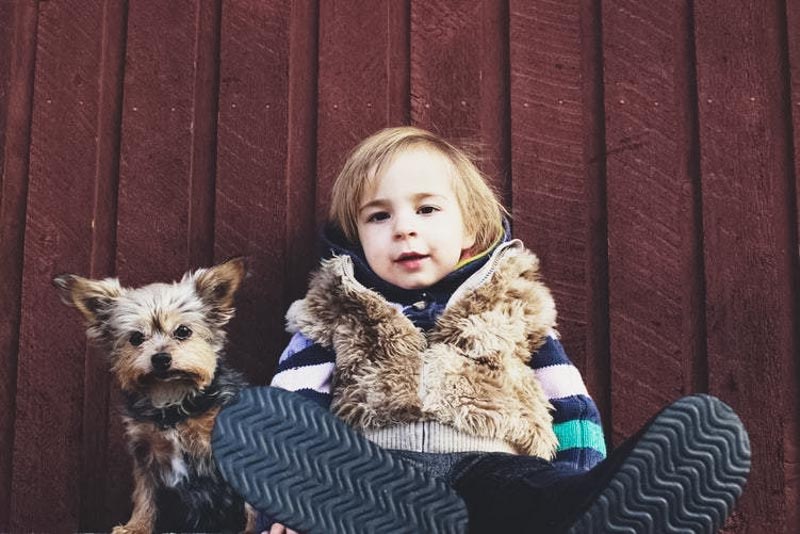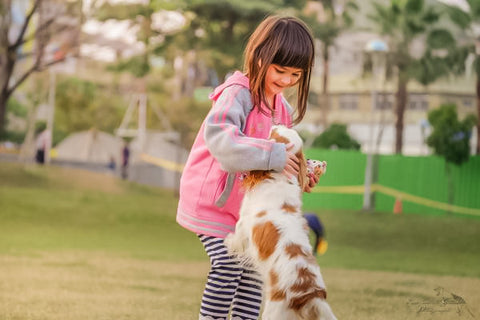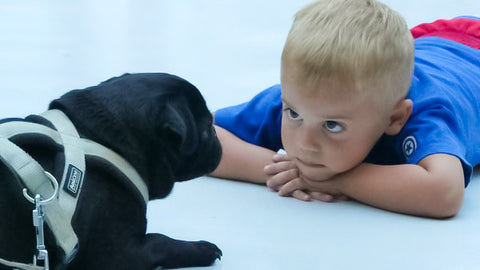
Getting the kids involved with training your dog is a win/win! It will give them both mental and physical exercise as well as a lifelong set of skills to enhance the human/animal bond. Plus, dogs just love positive training sessions.
This guide will give you three great trick ideas that are simple to train dogs while also teaching your child some fundamentals of dog training in the process. You can enjoy dog training with the kids in no time.
Getting Prepared: Puppy Training for Kids
Here are a few tips to make sure your child's training sessions go smoothly. These should help you when you start to implement the training games below!
Make Training a Game
The trick to teaching both your kids and dogs to enjoy training time is to keep the tone positive and focused on success. Both children and dogs love a game that they’re always winning!
As an adult, it is your job to set your child and dog up for success by setting the bar low, and raising it only as both are ready. Keep sessions short to avoid frustration which will spoil the fun for your dog.
Use Food Rewards
Food rewards are preferred by pro trainers because they are easy to repeat rapidly without disturbing focus. You can use part of your family dog's regular food rations for training sessions but add a few small extra tasty bits such as cheese, cooked chicken or store-bought soft treats to keep them extra motivated to learn.
Once your dog fully learns a trick, you can start to “fade” the food rewards by transitioning to praise or a toss of their favorite ball.

Ignore Failure, Reward Success
Training sessions are not the place for punishment. Instead, just reward success and ignore failure. This will help you teach your dog to be confident and unafraid to try new things, often leading to that next amazing trick!
Sometimes, children automatically use words like "No!' during training sessions, but you can patiently remind them that "No!" should be saved up for when the family pet breaks the rules outside of a training session. Otherwise, you can "wear it out" to the point that it no longer has meaning for your dog. This is particularly important when teaching kids about puppy training.
Mark/Reward
The most important part of family dog training is to learn how to effectively pair a mark and a reward. You can use a special word such as “YES!” or a dog training clicker for your mark. You make the mark when the dogs give you what you want, always followed by a reward.
The learning curve with training for kids is often about gaining skill with timing the mark to exactly when the dog is giving the right behavior to earn them a reward, and then slowly raising the criteria until the trick is learned by your dog.
Now that we’ve got those things out of the way, let’s start learning some tricks!
1. Recall: The Most Important Dog Trick
Every dog should learn to come running when they are called. This critical behavior can save a dog’s life if they happen to slip their leash near traffic or find an escape route out of a weak spot in your fence.
This is a perfect first puppy training with kids exercise! Even dogs as young as a few months old can start learning to come when called. It is also a great dog trick to teach kids to be enthusiastic and excited about working with canines.
Basic Training for Recall
Plenty of rewards for success and practicing in a variety of environments are what teach bulletproof recall for your dog.
Start indoors where there aren’t a lot of distractions. Give everyone a small bag of kibble laced with a few special treats. Take turns calling the dog then mark and reward when the dog gets to the person that called him.
It is important to only call your dog once, although being fun and silly to attract the dog’s attention is totally appropriate and encouraged.
Once your dog is used to the process inside your home, take him and your child to an outside area that is secured (such as a fenced yard) or with a long leash or rope for safety to practice outdoors away from strange people or other animals. Have the kids start close by, but move further away from each other to increase difficulty.
This behavior or game can be combined with a hide and seek if you have multiple children. Emphasize the need to mark and reward each success and remember to keep the tone playful.
Remember: Never trust that your dog's off-leash recall is perfect. Keep them on a leash when outside of a fenced area for safety.

2. Got Your Tail: A Great Trick for “Luring”
“Got your tail” is a way to teach your dog to spin, and is one of the silly tricks to teach your dog that can illuminate what’s possible when you spend time training. Many easy tricks for dogs are exciting, and it’s surprising how little time and effort they can take.
Luring is a powerful building block technique used by professional trainers for dogs. It involves holding a treat, allowing the dog to sniff it, moving your hand away slowly so the dog follows with her nose, then allowing her to have the treat when the movement is complete.
To train “Get your tail!” have your child lure your dog around in a small circle, then mark/reward after he spins all the way around. Repeat this exact procedure 5 times.
It is important to transition off the lure as soon as possible. To do this, have your child make the same movement, but this time without the treat. Once the movement is complete, mark/reward again, this time from the treat pouch. Repeat about 10 times until both “get it.”
Now, the goal is to abbreviate the hand motion. This is a gradual process, but the objective is to go from a big motion all the way around the dog to a very small and subtle movement of the finger.
It may take a few training sessions to accomplish, but gradually abbreviating the movement each time, followed by plenty of marks/rewards for success, will soon result in an amusing spin with just a flick of the finger and an eager puppy who chases his tail on command!
3. Stay: Impulse Control for Dogs and Kids
Stay is not only an excellent skill for dogs, but it is also a trick that will teach kids how to slowly raise the criteria for success – a critical dog training fundamental.
Have your child ask the dog to sit. Have her say the cue “Stay” with a palm open and facing the dog for the hand signal. If the dog will sit and stay for even 2 seconds, mark and give a treat and praise.
The trick is to slowly raise the bar, expecting a little more time sitting and staying before marking and giving a treat. Ignore failure, but if it happens too often, it is time to go back to a shorter period of time and raise the criteria more slowly.
Once you have a dog that will sit and stay for 30 seconds, you are ready to add some movement to this game. Just a little at first, a few steps before marking/rewarding a successful sit and stay. Eventually, your child can walk around your dog, go into another room, or hide before calling your dog to her. What fun!

Time to Get Started!
Remember to keep your training sessions short (15-20 minutes long) with full focus on success and reward. Soon you will have a child that is interested in dog training, and a dog that really appreciates how fun learning is! Puppy training for kids isn’t as complicated as it seems and there are plenty of simple tricks to teach your dog that will last a lifetime.
Training dogs is a great gift to give your kids - the furry and not-so-furry ones.
References:
https://www.akc.org/expert-advice/training/reliable-recall-train-dogs-to-come-when-called/*
https://www.onegreenplanet.org/animalsandnature/why-it-is-important-to-raise-kids-around-animals/*
https://www.dupontvet.com/blog/positive-reinforcement-training-why-it-works/*

